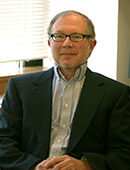科研训练 理科
Project Base Learning Science
- 有机化学——结构、反应和合成
- 以相关性统计及机器学习分析亚...
- 机体发育与癌症病变中的转录调...
- 神经科学与认知心理学:意识和...
- 天文学前沿探秘 - 系外行星遨...
- 分子生物学:分子层面的记忆和...
分子生物学:分子层面的记忆和记忆疾病
Molecular Biology of Memory and Memory Diseases
Samuel Kunes
哈佛大学分子与细胞生物学终身教授
1)哈佛大学生物科学委员会和生化科学导师委员会知名成员
2)Pew 生物医学科学基金学者项目获得者
3)Damon Runyon-Walter Winchell 基金会专项资金获得者
4)获得美国和国际专利:调节记忆的成分和方法( 专利号: 60/726,318)
课题背景
人类的身体,就像是一个由很多细胞组成的王国;而在每一个细胞里,又有很多携带着遗传信息的“小纸条”,它们就是DNA。DNA上,有一些叫做基因的片段。它们决定了你有棕色的眼睛,黑色的头发,黄色的皮肤,也规定了你身上的每一种细胞负责干什么。可以说,基因,就像是人体的代码。有了这组漂亮的代码,我们人体这个复杂的程序,才能跑得起来。本课程主要进行基因研究。
课题内容
本课程主要目标是教授科学思维,包括如何设计实验和从实验中获取知识,前两周主要包括从现代生物学的重大发现来学习科学思维和实验:
1. DNA 复制机理;
2. DNA序列分析;
3. 由双链RNA引起的基因默化:RNA 干扰;
后两周将集中在课题研究:
1.阿兹海默症研究--淀粉样前体蛋白(APP)的作用;
2. 组蛋白脱乙酰酶和癌症研究---细胞内蛋白质的化学修饰;
3.麻醉和意识---麻醉药剂与大脑神经元直接的相互作用。
适合人群
对生物专业感兴趣的高中生,本科生
修读生物科学、生物技术等专业,以及未来希望在国家科研机构、技术开发、教学及管理创新等领域从业的学生
具备数学、物理、化学等方面的基本理论和基本知识的学生优先
教授介绍
Samuel Kunes
哈佛大学分子与细胞生物学终身教授
1)哈佛大学生物科学委员会和生化科学导师委员会知名成员
2)Pew 生物医学科学基金学者项目获得者
3)Damon Runyon-Walter Winchell 基金会专项资金获得者
4)获得美国和国际专利:调节记忆的成分和方法( 专利号: 60/726,318)
任职学校
哈佛大学(Harvard University),简称“哈佛”,坐落于美国马萨诸塞州波士顿都市区剑桥市,是一所享誉世界的私立研究型大学,是著名的常春藤盟校成员。截至2018年10月,哈佛大学共培养了8位美利坚合众国总统,而哈佛的校友、教授及研究人员中共走出了158位诺贝尔奖得主(世界第一) 、18位菲尔兹奖得主(世界第一) 、14位图灵奖得主(世界第四) ,其在文学、医学、法学、商学等多个领域拥有崇高的学术地位及广泛的影响力,被公认为是当今世界最顶尖的高等教育机构之一 。2017-2018年,哈佛大学位列世界大学学术排名(ARWU)世界第一 、USNews世界大学排名世界第一 、QS世界大学排名世界第三 、泰晤士高等教育世界大学排名世界第六 。
课程安排与收获
• 8周在线小组科研(总课时78小时)
• 网申推荐信
• 学术评估报告
• 项目成绩单
• 论文成果
课纲
Molecular Biology of Memory and Memory Diseases
Prof. Sam Kunes
Memory is a central capability of our brains and critical to who we are as people
– for example, when people lose their memories as happens in Alzheimer’s Disease, they lose their personal identities. In this course we will study memory – what it is, how the brain learns and stores memory, and how the brain uses memory to change behavior. This is what allows animals to benefit from experiences, irrespective of whether the experiences are good or bad.
So what is memory? Rather than a complete record of experience, our brains select fragments of experiences, like the image of a face, critical facts and emotions (memories, after all, can be pleasant or painful – they are associated with our emotions). We store memory as a cellular and molecular change in the ‘neural circuits’ of our brains. An alteration in neural circuits, in fact at particular synapses (the connections between neurons), changes the communication between neurons and thus alters our thoughts and behavior.
The course will also take a holistic approach to the science of memory. We will begin with basic research in molecular biology, introducing mechanisms of DNA and RNA replication, as they occur in cells and viruses. There will be an emphasis on learning to think and reason creatively, with examples drawn from important discoveries that led to great advances in science and were rewarded with the Nobel Prize. You will get to practice your own skill of observation and reasoning in your research projects, in which you will design experiments to test your ideas. Employing reason and creativity, students will learn how to deal rationally with problems, whether in science or in other areas of their lives.
Program Schedule
Session 1: Experimental Discovery and the Foundations of Molecular Biology
➢ Experimental creativity and the experimental method are best
illustrated by the major discoveries of RNA and DNA biochemistry that serve as the foundations of modern molecular biology. These discoveries will serve as our introduction to essential experimental methods. Topics: DNA replication, the genetic code, the structure and properties of RNA and proteins and how they catalyze biochemical reactions
Session 2: Behavioral Definitions of Memory
➢ Memory is defined either through our own experience, with humans as the ‘model system’, or using animals as experimental models. Here we will define memory by examining human models for memory loss and associated brain lesions and how memory is measured in experiments with animal models. We will examine the structure of the brain and the specific functions of structures such as the hippocampus in memory.
Session 3: Neurons, Circuits and Synaptic Potentiation
➢ Memories are stored in the brain as changes in the synapses that mediate communication between neurons in circuits. Here we will focus on the electrophysiological tools to measure the communication between neurons and the change (plasticity) at synapses that is associated with memory formation. We will learn about how neurotransmitters interact with specific neurotransmitter receptors to mediate the potentiation (increase) of neural signaling associated with memory formation.
Session 4: Project Background Materials Week.
➢ The three project areas (described below) will be reviewed in this week in separate lectures, as students decide which topics to pursue for their class research project.
Session 5: Memory Coding at Synapses; Synapse Plasticity
➢ Synapse potentiation is a change brought about by biochemical mechanisms in the neural circuit. We will study the landmark papers that discovered these mechanisms in the rodent hippocampal neural circuit and other model systems such as Aplysia californica and Drosophila melanogaster.
Session 6: Focus on Research Projects and Team Presentations
➢ We will focus on research projects and preparations for project presentations and final reports.
➢ Memories can be fleeting or last a lifetime – the stability of a memory is determined by the molecular mechanism used to change synapses.
Session 7: Research Project Meetings and Experimental Design
➢ In this session we will discuss projects and the requirements of good experimental design
Session 8: Team Presentations and Discussion
Curriculum Learning Objectives:
➢ Learning to think like a creative scientist: To understand how to think like a scientist, we will study how scientists describe their experiments in original research articles. We will first focus on classic research papers that teach the ‘art and logic’ of experimental design. What is experimental design? Students have been introduced to basic ideas such as experimental constants, variables and controls. A higher-level skill for successful research is to ask the right questions; questions that are important and which are practical - that is, can be answered by logic and/or experiment. The exciting part of an experiment is the data. What do you do with experimental data, how do you interpret it and when can you draw a conclusion? It is important to learn to observe and ‘see’ facts clearly, without a view clouded by excited expectations or disappointment when results are not as expected. Most important discoveries are made by a clear and rational mind.
➢ Understanding advanced technology and research: Science goes forward hand-in-hand with the development of new technological tools. Consider this analogy; to build a house you will make a design that uses the tools and materials that are available, or, if your design requires a tool that doesn’t exist, perhaps then you will have to invent it. In science we do something similar – we design experiments using the technology that is available or we invent new technology as needed to do what we want to do. The students will see this clearly in the research papers we read and the experiments we talk about. Our readings and discussions emphasize the connection between the development of technological tools and answering fundamental questions about Nature.
Team Research Project Curriculum:
The class will be divided into three research teams. Each team will be assigned to a specific research project, which will be the subject of each student’s final paper and presentation. Teams will work together on their assigned research problem to devise a hypothesis and experiments to test their hypothesis. Below is a brief introduction and background for these projects.
Project 1: New Neurons in an Adult Brain and their Role in Memory and Emotion In 1953, the famous patient H.M. had a part of his brain removed, which was the only way to treat his very serious epileptic seizures. Afterward, H.M. could only remember
things that he had learned before the surgery, but he could not learn anything new. He could not even remember what he had said just one minute after he said it, so he would say the same thing over and over again. It turns out the region the surgeons had removed was a part of the brain called the Hippocampus. This ‘accident’ led to the understanding that the Hippocampus is one of the most critical brain structures for learning and memory. The Hippocampus is also one of the few locations in the adult brain where there are dividing cells that create new neurons throughout a person’s life. And, there is evidence that making these new neurons is important for forming new memories. In this project, you will study the molecular mechanisms that control the formation of new neurons and ask whether a problem with making new neurons is one reason that older people begin to have difficulties with learning and memory.
Project 2: What Causes Alzheimer’s Disease?
Alzheimer’s Disease (AD) is a quickly progressing dementia that includes loss of memory and cognitive ability. The progression of symptoms provides doctors with a time window in which they could treat and perhaps cure the disease, before too much damage is done. However, there is currently no treatment that works. The most widely accepted explanation for the cause of AD is the Amyloid Cascade Hypothesis. Yet so far drugs designed on the basis of this hypothesis have failed to help patients; so perhaps the hypothesis is wrong. Thus we are searching for new ideas and a new explanation for the cause of AD.
The Amyloid Cascade Hypothesis posits that the disease is caused by accumulation in the brain of a small protein called Amyloid Beta (Aβ), which causes the death of neurons and loss of connections (synapses) between neurons. The Aβ protein is cut from a larger protein called the Amyloid Precursor Protein (APP). Given that the focus on Aβ as the causative agent of AD has not been fruitful and that there is a lot of evidence that the APP protein is somehow involved in AD, we will consider other molecular mechanisms by which the APP protein might cause AD. One The students will create their own hypotheses to explain how APP might cause Alzheimer’s Disease and develop plans for experiments to test their hypotheses.
Project 3: Exploration of the Prediction Error Model of Learning
Studies in primates and mice indicate that neurons a brain region called the Ventral Tegmental Area (VTA) respond to a learning situation by releasing a neurotransmitter called Dopamine (a neurotransmitter is a signal from one neuron to another). The VTA neurons release Dopamine whenever the animal has an experience that is different from
what it had expected. When a mouse hears a new sound, it doesn’t expect a reward. But, in an experiment, if the sound is followed by sugar water, it will learn the association. The difference between an actual experience and an expectation is known as ‘predication error’. The VTA neurons respond to ‘prediction error’ by releasing Dopamine. The Dopamine then changes connections between neurons in a way that changes the animal’s expectation and thus future behavior. The next time the mouse hears that sound, it will show it expects sugar water by using its tongue to lick. If in the future, the sound is no longer followed by sugar water, the dopamine neurons once again signal a ‘prediction error’ and via their activity update the animal’s expectation. In this project, you will study the circuits of the cortex and VTA region to understand the mechanism of prediction error learning.
Course Assignments and Evaluation:
Prof. Kunes will provide each student with an evaluation of their work at the end of the course. The evaluation will be based on the assignments and also class and team participation as follows:
Research Project Paper and Presentation.
Paper. Each project team will be given a specific research problem to answer with a hypothesis and experiments to prove (or disprove) the hypothesis. Team members will work together to form their hypothesis and design experiments. However, each team member should write his/her own research proposal paper without the help of other team members. In your paper, describe the experiments and what the results might be and how the results would be interpreted. This assignment offers you the experience of reading and thinking about the experimental literature, generating new ideas and crafting experiments, just as real science is done.
Presentation. Each team will provide a 30-minute formal presentation of its hypothesis and proposed experiments during the last week of the class.

.png)



 粤公网安备 44010402002828号
粤公网安备 44010402002828号
